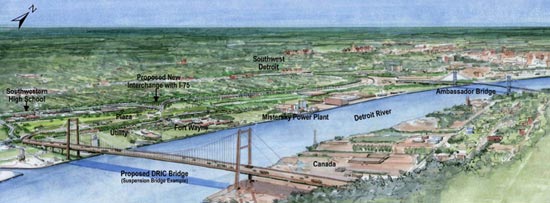Canadians make bid to move construction on Detroit River bridge
Date Posted: May 14 2010
DETROIT – Construction of a new Detroit River International Crossing into Windsor is getting momentum, spurred along by the April 29 offer of $550 million to the State of Michigan by the government of Canada to get the ball rolling. The funds would be repaid by toll revenues.
“Today,” said Michigan Gov. Jennifer Granholm at a press conference, “what the government of Canada has essentially recognized is that Michigan has some budget troubles and they have agreed to partner with the U.S. government to bear the cost of the Detroit River International Crossing.
“We knew in Michigan that there would be issues related to cost and essentially what Canada has said is that this would truly be a partnership and that they would absorb that initial outlay and that they would be repaid by toll revenues. We know that we have a need and know that it creates jobs for the state of Michigan, in a state that has the highest unemployment rate in the nation. That is an enormous gift to our citizens.”
The Ambassador Bridge, completed in 1929, is the busiest border crossing in North America, and carries 25 percent of the goods traded by the U.S. and Canada. The Ambassador is in need of structural repairs, but with proper maintenance there are few concerns about the long-term viability of the bridge. The greater concern of local and state governments in the U.S. and Canada, is that the Ambassador Bridge is privately owned by Michigan billionaire Matty Maroun – and he essentially has private control of an extremely important public crossing.
Maroun also wants to build a new bridge that he would also own, right next to the Ambassador.
Government officials on both side of the Detroit River also agree that a publicly owned bridge is a necessity in case of a terrorist attack on the Ambassador, because a second span would ease any future border congestion, and to keep the Detroit-Windsor crossing the preferred crossing route between the two nations. (A second span is also being considered at the crossing at Buffalo and Fort Erie, Ont.).
A new bridge and related approach work is estimated to cost a total of $5.3 billion, with $1.8 billion of work on the U.S. side. The span would be built using 80 percent federal funds/20 percent Michigan funds. The bridge’s approach in Detroit is planned to be built in the Delray area, about two miles down river from the Ambassador Bridge.
At least one state Republican is on board with the Detroit River International Crossing. “It will be a huge boost to the county, region and state,” said Oakland County Executive L. Brooks Patterson. “The DRIC should be implemented immediately by the state legislature. If we do not act quickly on this once-in-a-lifetime opportunity, we’ll watch a new border crossing built between Canada and Buffalo (N.Y.).”
For the building trades in Michigan, the governor’s announcement brings forth two main questions: When will work start? And with Canada willing to front money for the project, will Canadian building trades workers build the entire bridge?
The answer to the first question offers better news than you might expect. According to planners at the Detroit River Crossing Project, the start of work could move quickly – as early as this year. All approvals have been received from Canadian and U.S. governments, the U.S. Coast Guard, and the Michigan Department of Transportation. The last approval needed would come from the Michigan Legislature, which has given itself a June 1 deadline to make a decision.
Planners say the bridge could take four to five years to build. Work would include a plaza and a connection to I-75.
As for the second question, Michigan Building and Construction Trades Council President Patrick “Shorty” Gleason quickly diffused any theories that Canadian iron workers and other trades would work anywhere past their side of the international line in the middle of the Detroit River.
“It’s not going to happen,” Gleason said. “Canada is going to get their money back from the tolls. We already have a template in place for how this will work when we built the second Blue Water Bridge (from Port Huron to Sarnia, Ontario). We’ll do our work on our side, and the Canadians will do their work, and we’ll meet in the middle. And we’ll all do a damn good job.”

THE NEW DETROIT River crossing would be a traditional suspension bridge, according to this rendering.
